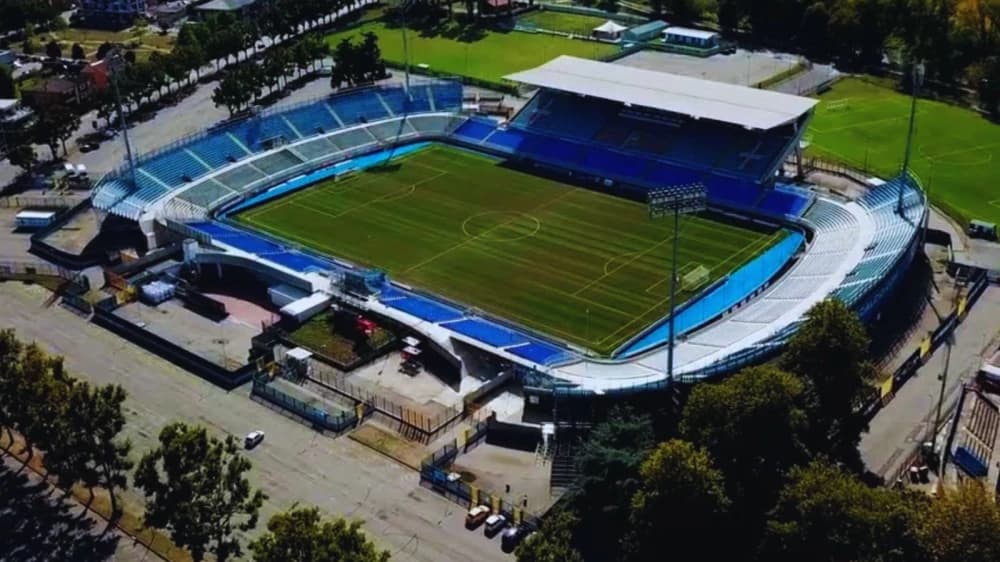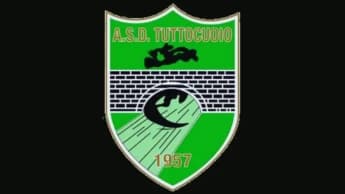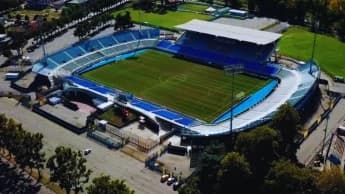
Stadion Rajko Mitić, a legendary venue for football in Serbia, resonates with rich history and passionate fan culture, symbolizing the spirit of the beautiful game.
Overview
Stadium Rajko Mitić, commonly called the "Marakana," is the largest stadium in Serbia and one of the most renowned football venues in the Balkans. Situated in Belgrade, the capital city, it serves as the home ground for Red Star Belgrade (FK Crvena Zvezda), a club with a rich history and a passionate following. The stadium is named after Rajko Mitić, an iconic player for Red Star and the team's first captain, honoring his significant contributions to the club and Yugoslav football.
The concept of building a new stadium originated in the 1960s as Red Star aimed to create a larger and more modern facility to serve their increasing number of supporters. Construction began in 1960 on the site of the previous FK Jugoslavija stadium and was finished in 1963. The stadium was officially inaugurated on 1 September 1963, initially boasting a capacity of over 100,000, making it one of the largest stadiums in Europe at that time. It earned the nickname "Marakana" inspired by the size and impressive design of Brazil's Maracanã Stadium.
In its first match, Red Star Belgrade faced off against Rijeka in the Yugoslav First League, heralding a new era in Serbian football. Over the years, Stadion Rajko Mitić has been the venue for countless memorable matches, both at the national and international levels. It has served as the backdrop for Red Star’s supremacy in the Yugoslav and Serbian leagues, as well as their legendary 1990–91 European Cup journey, which ended with the club being named champions of Europe.
The stadium was the site of Red Star's victory over Bayern Munich and other elite European teams on their journey to the final in Bari, Italy, where they triumphed over Olympique de Marseille to claim the prestigious trophy. When they returned to Belgrade, more than 100,000 supporters flocked to the Marakana to celebrate their champions, marking it as one of the most memorable celebrations in Serbian sports history.
In addition to club football, Stadion Rajko Mitić has been the home ground for the Yugoslav national team and subsequently the Serbian national team. It has hosted numerous international matches, including UEFA qualifiers and friendly games. The stadium is known for its intimidating atmosphere, created by the passionate Red Star supporters called “Delije,” making it one of the most challenging venues for visiting teams.
Over the years, the stadium has undergone multiple renovations to comply with contemporary safety and comfort standards. Its seating capacity has been adjusted to approximately 52,000 spectators, yet the essence of the original Marakana persists. Significant upgrades include the addition of floodlights, electronic scoreboards, VIP boxes, state-of-the-art press facilities, and enhanced locker rooms. In 2014, the stadium was officially renamed in honor of Rajko Mitić, ensuring that his legacy remains forever associated with the venue.
Stadion Rajko Mitić is more than just a sports venue; it represents the essence of Serbian football culture. It embodies years of victories, rivalries, and the unwavering passion of its supporters. The legendary derby between Red Star and Partizan Belgrade takes place here multiple times each season and is renowned as one of the most intense football rivalries globally, attracting significant attention for its thrilling atmosphere and fierce competition.
Currently, the Marakana continues to host domestic league games, Serbian Cup matches, and European tournaments. It remains the spiritual center of Red Star Belgrade, a location where history is alive in every chant, every flag, and every goal scored. Whether in sunlight or under stadium lights, Stadion Rajko Mitić serves as a grand tribute to the unifying and inspiring power of football.
Historical Overview and Building Techniques
Construction of Stadion Rajko Mitić, commonly referred to as the “Marakana,” commenced in the late 1950s out of necessity, as Red Star Belgrade aimed to establish a modern and larger stadium to replace their previous venue. The site selected for the new stadium was where the old FK Jugoslavija ground had been located, which had been in operation since 1927. Following World War II, Red Star assumed control of the stadium after the disbandment of FK Jugoslavija by the new communist regime. As the popularity of football surged and Red Star's fanbase grew, the old stadium could no longer handle the rising number of spectators.
The planning for the new stadium began in 1959, with the official construction kicking off in 1960. This ambitious project entailed the complete demolition of the old Jugoslavija ground, followed by significant excavation efforts. It is estimated that more than 350,000 cubic meters of soil were excavated to lower the pitch level, resulting in a bowl-like configuration that enhanced spectator capacity. At the time, the project was regarded as a remarkable architectural and engineering feat in Yugoslavia.
The design included a large concrete structure with steep stands, providing excellent visibility from every angle and enhancing the sound of cheering fans. Originally, the stadium was constructed to hold more than 100,000 spectators, making it one of the largest football stadiums in Europe. Its immense capacity led to its nickname "Marakana," about the famous Maracanã Stadium in Rio de Janeiro, Brazil. The design and size of the facility were meant to embody the rising aspirations of both Red Star Belgrade and Yugoslav football.
The construction was finished in 1963, and the stadium was officially opened on September 1 of that year. The inaugural match featured Red Star Belgrade against Rijeka in the Yugoslav First League, attracting an audience of around 55,000. In the subsequent years, the stadium often hosted matches with attendance exceeding 90,000. At its maximum, the official capacity was listed at 110,000, although actual attendance frequently surpassed this figure due to standing areas and lenient ticketing policies.
During the 1960s and 1970s, the Marakana transformed into a stronghold for Red Star Belgrade and served as an important venue for the Yugoslav national team. It was the stage for numerous prestigious domestic matches, international friendly games, and competitive events. The electric atmosphere, particularly during derby clashes with archrivals Partizan Belgrade, made the stadium a daunting place for opposing teams.
Over the years, numerous renovations and safety enhancements have been implemented. In the 1990s, to comply with the evolving standards set by UEFA and FIFA, the stadium's capacity was reduced to prioritize safety and comfort. Standing terraces were gradually transformed into all-seater areas. Other upgrades included the installation of floodlights, the addition of modern VIP and media facilities, renovated locker rooms, and enhanced access for players and officials.
In 2008, a new electronic scoreboard was introduced, and further improvements were made in the subsequent years. However, the essential architectural character of the Marakana was preserved, keeping its distinctive bowl-shaped design and commanding presence intact.
In December 2014, the stadium was officially renamed Stadion Rajko Mitić to honor the legendary captain of Red Star and one of the most respected figures in the history of Yugoslav football. This renaming served as a symbolic act, linking the stadium's legacy to one of the club's most celebrated icons.
Today, Stadion Rajko Mitić serves not only as a historical landmark in Serbian sports but also as a vibrant reminder of the country's football heritage. Its construction and evolution over the past sixty years mirror the developments in football infrastructure as well as the shifting social and political dynamics of the region.
Features of Architecture and Design
Stadion Rajko Mitić, commonly referred to as the "Marakana," is one of the most significant and recognizable stadiums in Southeast Europe. Established in the early 1960s, its architectural design was centered on functionality, capacity, and ambiance. The goal was to create a massive football arena that would mirror the prestige of Red Star Belgrade and accommodate the increasing number of fans supporting the team, both locally and internationally.
The stadium was built in a natural depression in the landscape, resulting in a bowl-shaped structure. This architecture ensured that every seat offered an unobstructed view, which was a crucial factor during the planning process. To achieve this bowl effect, engineers removed over 350,000 cubic meters of soil, lowering the pitch several meters below ground level. This not only increased the stadium’s capacity but also improved its acoustics, enhancing the sound produced by the fans and solidifying its reputation as a hub of football passion.
The stadium was originally designed to hold over 100,000 spectators, with the official attendance record reaching 110,000. Its structure comprised large concrete terraces with steep inclines, allowing for a maximum number of fans in a relatively small area. The stands encircled the pitch in a continuous ring, intensifying the matchday atmosphere and fostering a sense of community among fans. The upper tiers offered panoramic views of both the field and the city beyond, making the venue not only functional but also visually impressive.
A prominent feature of the Stadion Rajko Mitić’s architecture is its symmetry and balance. The east and west stands were crafted to reflect each other, while the north and south stands completed the oval-shaped enclosure. The main structure of the stadium was built using reinforced concrete, a widely used building material at the time, recognized for its durability and strength. Additionally, the design incorporated several entrance and exit points around the stadium's perimeter, promoting safe and efficient movement of crowds, particularly during large events.
Originally, the stadium had very little roofing, leaving most of the seating exposed to the weather. However, as part of its renovations over the years, certain areas, especially for VIPs and the press, were eventually covered to offer protection. Nevertheless, the stadium maintained much of its open-air essence, which contributed to the ambiance and splendor of significant events.
The stadium underwent renovations that included the installation of floodlights, enabling night matches and enhancing the venue's adaptability for international events. The introduction of electronic scoreboards modernized the experience for fans. Additional improvements featured upgraded seating, with plastic seats replacing the original concrete terraces, transitioning to an all-seater setup to meet UEFA regulations. While these updates reduced the overall capacity to around 52,000, they significantly enhanced comfort and safety standards.
The design also prioritized accessibility and infrastructure. The stadium was seamlessly integrated into the urban landscape of Belgrade, with nearby roads, public transport stations, and parking options providing ease of access for fans. The internal configuration featured specific areas for team facilities, medical services, locker rooms, and media operations. The press zone was upgraded to include broadcasting booths and high-speed communication lines, ensuring that the stadium fulfilled the standards set by international media.
In recent years, VIP lounges and hospitality areas were introduced, boosting the stadium's commercial potential. Notably, the western stand underwent renovations to accommodate club offices and operational headquarters. Despite these updates and enhancements, the architectural integrity of the Marakana has been preserved, maintaining its historical significance and emotional resonance for fans.
The design of Stadion Rajko Mitić is a blend of monumental scale, practical engineering, and intense atmosphere. It remains a significant symbol of Serbian football, representing both historical significance and contemporary functionality.
Ambiance and Spectator Experience
Stadion Rajko Mitić, commonly referred to as the "Marakana," is celebrated throughout Europe and the world of football for its vibrant atmosphere and passionate fan engagement. As the home ground of Red Star Belgrade, one of the most successful and storied football clubs in the Balkans, the stadium has consistently served as a bastion of emotion, fervor, and steadfast support. It stands as a place where football transcends mere sport—it embodies a way of life.
As fans start to gather around the stadium hours before kick-off, an unmistakable sense of excitement fills the atmosphere. The streets surrounding the venue are alive with red and white hues, while vendors offer scarves, flags, and memorabilia. The aroma of grilled food and the sound of chants reverberating through Belgrade add to a vibe that is both festive and charged with enthusiasm. For many supporters, attending a match at the Marakana is a cherished tradition passed down through generations.
The experience for fans at Stadion Rajko Mitić is greatly enhanced by the passionate supporter group of Red Star, known as the “Delije.” Stationed primarily in the north stand, the Delije are recognized for their unwavering support, organized displays, powerful chants, and impressive pyrotechnics. Their enthusiasm turns the stadium into a vibrant spectacle filled with color, sound, and energy. On match days, particularly during significant events or European matches, their tifos and banners fill the stadium, showcasing the club’s rich history, challenges, and victories.
One of the most renowned aspects of the fan experience is the Eternal Derby—featuring Red Star Belgrade against Partizan Belgrade. These matches are among the most intense and emotionally charged in global football. The atmosphere reaches a boiling point, with flares, smoke, and continuous chanting from both fanbases. The tension, excitement, and fervor of these derbies create a unique experience for many attendees. Although security measures are heightened during these events, the passion of the fans remains unwavering.
The Marakana's acoustics significantly amplify the noise within the stadium. Its bowl-shaped design allows chants and songs to resonate and intensify, creating a daunting atmosphere for visiting teams. The collective voices of the fans merge to form a powerful sound that motivates the home team and disorients the opponents. Even neutral spectators and fans from the visiting team frequently describe the noise as extremely intense, particularly during pivotal moments in the match, such as goals, controversial calls, or thrilling conclusions.
Fan rituals play a significant role in the overall experience. Supporters participate in activities such as singing the club anthem before the match begins, waving flags, and lighting flares, all of which foster a sense of unity and identity. Players frequently recognize this connection, with many referring to the supporters as an essential “twelfth man” in pivotal matches. This strong bond between the team and the fans significantly adds to the stadium's storied reputation.
The stadium has undergone considerable enhancements in recent years to improve the matchday experience. While maintaining the lively atmosphere and authenticity of traditional football fandom, renovations have been made in areas like seating, security, food and beverage options, and accessibility points. The addition of VIP lounges, family-friendly sections, and designated spaces for visiting supporters promotes a more inclusive and secure setting for all fans.
Even with these modern updates, the essence of the fan experience is still deeply intertwined with tradition and fervor. The standing areas that once permitted unrestricted movement and energetic support have been replaced with all-seater configurations for safety reasons, yet the excitement remains unwavering. Fans continue to sing, leap, and demonstrate their loyalty with unparalleled passion for the entire 90 minutes and beyond.
On European nights, the atmosphere at Marakana reaches an extraordinary level. Matches against major teams such as Liverpool, Bayern Munich, or AC Milan attract full stadiums and significant international attention. These evenings feature elaborate pre-match entertainment, stirring national anthems, and unforgettable displays by the fans. For many, it is during these events that Marakana reveals its true might, rekindling memories of Red Star’s 1991 European Cup victory and solidifying the club's status on the global stage.
The fan experience extends beyond just matchdays. Supporters of Red Star remain engaged year-round by organizing events, community initiatives, and club festivities. The stadium is regarded not only as the home of the team but also as a gathering place for a broader community united by loyalty and pride. The Delije, along with the entire fanbase, plays a crucial role in preserving the spirit and culture of the club.
The atmosphere and the experience for fans at Stadion Rajko Mitić are unmatched. It is a venue where history, identity, and emotions converge, resulting in one of the most genuine and fervent football experiences found anywhere in the world. The chants, the vibrant colors, and the energy in the stands all come together to create unforgettable moments at Marakana.
Documentation and Heritage
Stadium Rajko Mitić, commonly known by its historic name “Marakana,” has developed a strong reputation over the years as one of the most notable football stadiums in Europe. Besides its impressive architecture and vibrant atmosphere, the stadium boasts a profound and lasting legacy marked by numerous records and achievements that underscore its pivotal role in the history of Serbian and Yugoslav football.
The stadium officially opened on September 1, 1963, and over the years, it has hosted numerous domestic and international matches that have contributed to its legendary reputation. One of its most lasting records is its capacity during its peak years. Initially, the stadium could hold over 100,000 spectators, with an official maximum capacity recorded at around 110,000. This made it one of the largest stadiums in Europe and a venue for some of the most attended football matches in the region’s history.
The record attendance at Stadion Rajko Mitić was established during a 1975 match between Red Star Belgrade and Ferencváros in the European Cup. At that time, around 110,000 spectators filled the stadium to witness one of Red Star's pivotal European games. This attendance record remains a significant milestone in Serbian football, representing the fervor of the fans and the importance of the Marakana as a venue for historic events.
Red Star Belgrade's supremacy in local football is closely linked to its stadium. It has hosted countless title-winning seasons and championship festivities. Throughout the years, Red Star has secured numerous league titles, Serbian Cups, and Super Cups, with many of these victories celebrated at Stadion Rajko Mitić. The stadium has come to represent triumph and home advantage, as the team has experienced several lengthy unbeaten streaks at this venue.
A significant chapter in the stadium's history occurred during Red Star Belgrade's extraordinary 1990–91 European Cup journey. While the final took place in Bari, Italy, the Marakana hosted several unforgettable matches leading up to that moment, featuring intense encounters against Rangers, Dynamo Dresden, and Bayern Munich. These games were played in front of full houses, with the electrifying atmosphere and unwavering support credited with energizing the team on their path to becoming European champions. This victory stands as the pinnacle of Serbian club football achievements, and Stadion Rajko Mitić played a vital role in that triumph.
Regarding international matches, the stadium has been the home ground for the Yugoslav national team and, subsequently, the Serbian national team. It has hosted qualifying matches for both the World Cup and European Championship, alongside friendly games and matches against some of the best national teams globally. The stadium’s impressive structure and enthusiastic crowd create a daunting atmosphere for visiting teams, contributing to its reputation as a stronghold.
An important facet of the stadium's legacy is its renaming in December 2014. Previously called the “Red Star Stadium,” it was renamed Stadion Rajko Mitić in tribute to the legendary captain of Red Star and one of the club's most iconic figures. Rajko Mitić was not only a prominent player and leader during his career but also an emblem of sportsmanship and commitment. The decision to name the stadium after him has solidified its reputation as a national treasure and a monument to football excellence.
Throughout its history, the Marakana has also hosted significant non-football events, such as concerts, political rallies, and cultural gatherings, thus expanding its legacy beyond the world of sports. However, football has always been central to its identity.
The stadium has been extensively renovated to meet UEFA and FIFA standards, evolving from a large, predominantly open and terraced space into a fully seated venue equipped with modern facilities. Although these updates have reduced the overall capacity to about 52,000, they have maintained the historical essence of the stadium while prioritizing the safety and comfort of both fans and players.
The Delije, the dedicated fanbase of Red Star, have been essential in establishing the stadium's reputation. Their intricate choreographies, unwavering support, and iconic presence during crucial matches have become ingrained in the stadium's vibrant history. The connection between the fans and the stadium has fostered a legacy of emotional significance that goes beyond the game itself.
The Rajko Mitić Stadium is more than just a place for sports; it embodies pride, identity, and resilience. It serves as a reminder of a glorious history, a symbol of football excellence, and a guiding light for future generations of Serbian footballers and fans. Its records transcend mere statistics and accomplishments; they represent memories woven into the very essence of the stadium, echoed in every cheer, every song, and every victory celebrated within its confines.





